10 Questions to Ask Your Rhinoplasty Surgeon Before You Commit — An Evidence‑Based, Real‑World Guide
November 20, 2025
Rhinoplasty reshapes the nose’s framework and soft tissues to balance facial aesthetics while protecting (or improving) how you breathe. It’s also one of the most technically demanding operations in facial plastic surgery. Translation: who you choose matters—a lot. Your surgeon’s training, judgment, and approach heavily influence safety, satisfaction, and the odds you’ll need a revision.
Use the 10 questions below during a structured consultation. Ask for specifics. Request objective data. Take notes. Great surgeons welcome informed patients and answer with clarity and transparency—no hedging, no fluff.
Use the 10 questions below during a structured consultation. Ask for specifics. Request objective data. Take notes. Great surgeons welcome informed patients and answer with clarity and transparency—no hedging, no fluff.
Validate the surgeon’s credentials, scope of practice, and outcomes transparency
1) Are you board‑certified in plastic surgery or otolaryngology–head and neck surgery, do you have subspecialty rhinoplasty training, and what proportion of your practice is dedicated exclusively to rhinoplasty?
Why it matters:
- Board certification (American Board of Plastic Surgery or American Board of Otolaryngology–Head and Neck Surgery) signals rigorous training and testing.
- Fellowship training in facial plastic surgery or rhinoplasty means focused time with complex anatomy and revision cases—where details really count.
- A high rhinoplasty case mix builds pattern recognition, refined technique, and more predictable results. Practice makes… more consistent.
- “I’m board‑certified by ABPS/ABOto. I completed a facial plastic surgery fellowship with heavy rhinoplasty exposure. Rhinoplasty (primary and revision) is 50–90% of my practice.”
- Vague certification talk, no clear subspecialty training, or “I do a few rhinoplasties here and there.”
- “Do you maintain hospital privileges for rhinoplasty or nasal surgery?” Privileges = peer review of competency.
2) How many primary and revision rhinoplasties do you perform annually, what’s your revision rate over the past 24 months, and do you track standardized outcomes (e.g., NOSE/SCHNOS for function, FACE‑Q for aesthetics)?
Why it matters:
- Volume and a transparent revision rate are a reality check. Published literature reports overall revisions around 5–15%—higher with complex cases and certain patient factors.
- Standardized tools like NOSE (Nasal Obstruction Symptom Evaluation), SCHNOS (Standardized Cosmesis and Health Nasal Outcomes Survey), and FACE-Q anchor expectations and measure change you can actually see on paper.
- Clear annual volume (e.g., 100–200 cases; 20–40% revisions).
- A current, candid revision rate with context (“7% over the last 24 months—higher in complex revision cases”).
- Routine outcomes tracking pre- and post-op at consistent time points.
- No outcomes data, dodging the revision‑rate question, or dismissing validated tools as “not necessary.”

Assess aesthetic philosophy, planning rigor, and expectation alignment
3) How will you translate my goals into a surgical plan—do you use standardized photography, 3D imaging or digital morphing, and structured goal‑setting to calibrate realistic expectations?
Why it matters:
- Preop analysis drives intraop decisions. Standardized photos (frontal, oblique, lateral, base) allow precise assessment. 3D imaging and morphs can align expectations—but they’re illustrations, not guarantees.
- A structured approach (documented goals; a clear read on skin thickness, skeletal support, and airway constraints) prevents mismatched expectations and disappointment.
- Consistent photo protocol; meticulous facial analysis; optional 3D morphs; and a written plan that prioritizes key goals (e.g., narrow a wide dorsum, refine a bulbous tip, maintain/expand the internal nasal valve).
- Discussion of trade-offs (subtlety versus structural support, how thick skin affects tip definition and swelling).
- Over‑reliance on glam “afters,” promising to “match the morph,” or glossing over limitations.
- Thick skin? You might hear: careful supratip defatting, strong tip support with sutures and cartilage, and counseling that swelling resolves slower—especially at the tip.
4) May I see before‑and‑after results from patients with similar anatomy, skin thickness, and ethnic features—including frontal, oblique, profile, and base views at 12+ months—and can you walk me through which maneuvers produced those results?
Why it matters:
- Relevant photo sets—at least one year out—show stability, symmetry, and scar quality. Base views reveal tip support and nostril shape; frontal views highlight dorsal lines and width control.
- Surgeons who can map results to maneuvers (e.g., spreader grafts for valve support, lateral crural strut grafts for tip stability) are thinking deeply, not guessing.
- Specific, anatomy-driven changes: “We corrected internal valve collapse with spreader grafts and mild flare sutures; refined the tip with cephalic trim and transdomal/interdomal sutures; and used conservative osteotomies for a smoother dorsum.”
- Sensitivity to ethnic and gender aesthetics—refining proportion while maintaining your identity.
- Only cherry‑picked early results or refusal to show base/frontal views.
Understand technical approach, anatomical decision‑making, and functional preservation
5) Do you recommend an open or closed approach for my case, will you use preservation versus structural techniques, and what graft materials (septal, auricular, costal) and stabilization methods will you use to minimize warping or resorption?
Why it matters:
- Open (external) and closed (endonasal) both have their place. Open offers exposure for complex tip work or revisions; closed can suit fine-tuning with less soft-tissue disruption.
- Preservation rhinoplasty maintains native dorsum/ligaments; structural rhinoplasty rebuilds and stabilizes with grafts and sutures. Many cases blend both.
- Graft type and handling matter long-term. Septal cartilage first; auricular for contour work; costal (rib) when you need more support. Techniques like balanced carving, diced cartilage in fascia (DCF), PDS plates, or K-wire stabilization help control rib cartilage warping.
- A rationale tailored to your anatomy and goals.
- A clear graft plan (and a backup if septal cartilage is limited).
- How soft-tissue management (e.g., SMAS elevation plane, ligament preservation/reconstruction) helps reduce long-term edema and maintain definition.
- One‑size‑fits‑all, no plan if septal cartilage is scarce, or a hand‑wavy explanation of stabilization.
6) How will you diagnose and address functional issues—septal deviation, internal/external valve collapse, turbinate hypertrophy—and what techniques (e.g., spreader grafts, butterfly grafts, flaring sutures) will you use to preserve or improve airflow?
Why it matters:
- Cosmetic changes can harm airflow if valve and septal support are ignored. Every rhinoplasty is a functional operation—full stop.
- A thorough exam includes internal evaluation, dynamic collapse assessment (modified Cottle maneuver), and documentation of symptoms (NOSE/SCHNOS). In select cases, objective tests (rhinomanometry/acoustic rhinometry) help.
- Septoplasty with caudal/L-strut preservation; spreader grafts or auto-spreader flaps for internal valve support; lateral crural strut grafts or alar batten/butterfly grafts for the external valve; inferior turbinate reduction when hypertrophic.
- Extra caution in revision or narrow noses to avoid over-resection and collapse.
- Minimal attention to function or a plan to narrow aggressively without valve support.

Clarify safety protocols, anesthesia planning, and complication management
7) Where will the surgery be performed, what facility accreditation and infection‑control standards are in place, who administers anesthesia (board‑certified anesthesiologist or CRNA), and how will airway safety and blood pressure be managed?
Why it matters:
- Accredited facilities (AAAASF, AAAHC, The Joint Commission) maintain equipment, sterile protocols, emergency readiness, and peer oversight.
- An experienced anesthesia team reduces airway risk, bleeding, and nausea—and tailors plans for conditions like OSA, GERD, or prior anesthesia issues.
- An accredited ambulatory surgery center or hospital, standardized sterilization, appropriate prophylactic antibiotics, and a temperature-controlled OR.
- Anesthesia plan (usually general anesthesia with an endotracheal tube or LMA), multimodal pain control, anti-emetics, and intraoperative blood pressure control to limit bleeding.
- VTE risk assessment (e.g., Caprini score) with prophylaxis for higher-risk patients.
- Office surgery without accreditation, limited monitoring, or non‑specialist anesthesia providers without proper supervision.
8) What complications do you see most often (bleeding, infection, contour irregularities, over/undercorrection, tip asymmetry), how do you reduce these risks in the OR, and what’s your protocol for early detection and prompt intervention?
Why it matters:
- No one is complication-free. You want candor—and a plan.
- Typical ranges reported in the literature: significant postoperative bleeding ~1–3%, infection <1–2%, septal perforation <1%, prolonged edema or contour irregularities vary, need for revision 5–15%.
- Risk reduction: meticulous hemostasis, gentle tissue handling, conservative resection with structural support, antibiotic stewardship, thoughtful taping/splinting.
- Early interventions: urgent treatment of septal hematoma, clear infection management, massage/taping guidance, steroid or 5-FU injections for thick/fibrotic tissue when indicated, and reliable after-hours contact.
- “I never have complications,” or no after‑hours pathway.
Define recovery trajectory, cost structure, and long‑term follow‑up
9) What’s the expected recovery timeline—splints, taping, swelling by subunit, and key milestones—and what are the rules around exercise, eyeglasses, travel, and returning to work or contact sports?
Why it matters:
- Recovery comes in stages. Knowing the playbook lowers anxiety and helps you spot what’s normal versus what’s not.
- First week: External splint and internal supports if used; bruising/congestion peak days 2–4; splint off around day 6–8.
- Weeks 2–4: Most bruising clears; edema improves; many return to non-strenuous work ~7–10 days; gentle walking early; light exercise after 2 weeks if cleared.
- Weeks 4–6: Bones consolidate; resume moderate exercise; avoid contact sports. Eyeglasses usually off the nasal bones for 4–6 weeks—use cheek supports if needed.
- Months 3–6: Swelling continues to fade; tip and supratip settle slower than the upper third.
- Months 12–18: Final refinement, especially in thick-skinned or revision cases.
- Air travel is often fine after splint removal if you’re healing well (usually 1–2 weeks). Discuss cabin pressure, congestion, and access to care.
- Contact sports or facial-risk activities: typically off-limits for at least 6–8 weeks—longer depending on osteotomy patterns.
- Night taping early on to help swelling, diligent sun protection, silicone for the external columellar scar, and selective steroid injections for persistent supratip fullness.
- Vague or overly rosy timelines, or no written instructions.
10) What does the fee include (surgeon, facility, anesthesia, postoperative visits), how are revisions handled—financially and clinically—and what’s your follow‑up schedule through 12–24 months?
Why it matters:
- Transparent pricing prevents surprises. A defined revision policy sets expectations. Long‑term follow‑up catches late changes and supports stable outcomes.
- Itemized estimate: surgeon, facility, anesthesia, any implants/grafts, routine postop visits, and imaging if needed.
- Revision policy: criteria and timing (usually not before 9–12 months unless urgent), whether any portion of the surgeon’s fee is reduced or waived, and whether facility/anesthesia costs apply.
- Follow-up cadence: e.g., 1 week, 1 month, 3 months, 6 months, 12 months, 18–24 months—with validated outcomes surveys and standardized photos at major milestones.
- Murky fees, follow‑up that stops at 3 months, or blanket “no revision” policies regardless of outcome.

How to Use These Questions: A Practical Decision Framework
Prepare: List your priorities in order (e.g., “smooth the dorsal hump,” “refine the tip,” “breathe easier”). Bring old photos and your medical history (sinus issues, allergies, OSA).
Evaluate answers across four domains:
Evaluate answers across four domains:
- Credentials and outcomes transparency
- Aesthetic philosophy and planning rigor
- Technical/functional plan tailored to your anatomy
- Safety, recovery, and lifecycle care
- Objective data: case volume, revision rate, standardized outcomes.
- Case relevance: before-and-afters that look like you—at 12+ months.
- Communication: clarity, listening, realism, and willingness to discuss trade-offs and contingencies.
- Infrastructure: accredited facility, qualified anesthesia, after-hours support, long-term follow-up.
- Demonstrates deeper functional analysis,
- Shows stable, long-term results in patients like you,
- Offers the clearest plan (and a backup plan),
- And is transparent about revision policies.
Example: Turning a Goal into a Plan
Scenario: You have a moderate dorsal hump, a bulbous tip, thick skin, and right‑sided nasal obstruction.
A strong plan might include:
A strong plan might include:
- Open approach for precise tip work; preserve key ligaments when feasible to reduce edema.
- Septoplasty to correct deviation and harvest cartilage; spreader grafts for internal valve support; inferior turbinate reduction if hypertrophic.
- Controlled dorsal reduction with preservation or auto-spreader flaps to maintain valve angles.
- Tip refinement: conservative cephalic trim, transdomal/interdomal sutures, plus lateral crural strut grafts for symmetry and long-term support.
- Edema mitigation: meticulous soft-tissue handling, early taping protocol, and counseling that tip definition can take 12–18 months to fully declare in thick skin.
- Outcome tracking: baseline NOSE/SCHNOS and FACE-Q; follow-ups at 1, 3, 6, and 12 months with standardized photography.
Final Considerations
Rhinoplasty success rests on three pillars: a surgeon with focused training and transparent outcomes; a plan that aligns your goals with your anatomy and airway; and a care pathway that emphasizes safety and long‑term follow‑up. Use these 10 questions to cut through marketing and focus on measurable quality. Take your time. See more than one qualified surgeon if you can. Choose the team that communicates clearly, shows stable results in patients like you, and manages the entire journey—from planning to recovery to long‑term refinement.
No decision erases risk. But an informed one dramatically raises the odds of a nose that looks natural, functions well, and ages gracefully.
No decision erases risk. But an informed one dramatically raises the odds of a nose that looks natural, functions well, and ages gracefully.

Schedule Your Appointment with Dr. Mourad
If you are considering facial plastic surgery and want results that enhance your natural beauty without looking overdone, schedule a consultation with Dr. Moustafa Mourad today. You will receive personal, expert guidance at every step—from your first visit to your final result.
From Our Blog

December 8, 2025 | Dr. Moustafa Mourad | Uncategorized
Ethnic Rhinoplasty: Respecting Heritage and Identity Through Tailored Surgical Technique
Elective facial surgery is powerful. It can boost confidence, restore function, and reshape how someone is viewed—and how they view themselves. That’s especially true with rhinoplasty. “Ethnic rhinoplasty” isn’t a separate operation;
READ THE ARTICLE
December 8, 2025 | Dr. Moustafa Mourad | Uncategorized
Non-Surgical Alternatives vs. Surgical Rhinoplasty: What You Need to Know About Liquid Rhinoplasty (Filler) Versus Surgery
Elective changes to the nose sit right where aesthetics meets function. Some people want to smooth a small hump without taking time off work; others need true structural change and better airflow. Today, you’ve basically got two very different routes.
READ THE ARTICLE
December 8, 2025 | Dr. Moustafa Mourad | Uncategorized
Open vs. Closed Rhinoplasty: Which Technique Is Right for You? Differences, Pros, and Cons
Rhinoplasty isn’t one single operation—it’s a toolkit of techniques that reshape the nasal framework to improve how your nose looks, works, or both. The two main approaches—open (external) and closed (endonasal)—are simply different ways to reach the same anatomy.
READ THE ARTICLE
December 8, 2025 | Dr. Moustafa Mourad | Uncategorized
Which Type of Nose Surgery Is Best for You?
Your nose plays a big role in how your face looks and how you breathe. For some people, it’s about refining appearance. For others, it’s about improving airflow or correcting past surgeries. No matter the reason, the goal is the same: to create a natural, balanced result that fits your face and function.
READ THE ARTICLE